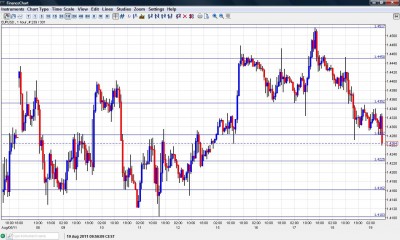Euro dollar is dipping below support as the stock market crash continues into the European session. Fears of a credit crunch in European banks and global recession weigh on the pair. Will the pair break out of the long term range?
Here’s a quick update on technicals, fundamentals and what’s going on in the markets.
EUR/USD Technicals
- Asian session: The pair traded in a range between 1.4282 to 1.4350 . The fall began at the wake of the European session.
- Current range 1.4220 to 1.4282.
- Further levels in both directions: Below 1.4220, 1.4160, 1.4070, 1.4030, 1.3950, 1.3838.
- Above: 1.4282, 1.4350, 1.4450, 1.4550.
- 1.4220 is only a minor line before 1.4160.
- 1.4350 proved to be a strong line on the upside.
Euro/Dollar sliding lower – click on the graph to enlarge.
EUR/USD Fundamentals
- 6:00 German PPI. Exp. +0.2%. Actual +0.7%. This is different from other inflation measures.
- 12:30 US FOMC member William Dudley talks. He is quite dovish.
* All times are GMT.
For more events later in the week, see the Euro to dollar forecast
EUR/USD Sentiment
- European Credit Crunch: One European bank couldn’t get US dollars from other banks and had to go to the ECB and pay a higher price. In addition, US regulators are worried about European banks. Some European banks are highly leveraged, close to Lehman.
- Terrible US data: The Philly Fed Index plunged to the lowest level since March 2009. Also other figures such as jobless claims and existing home sales were terrible. The bad US figures and the European banking worries sent global stock markets lower yesterday in Europe, then in the US, then in Asia, and now in Europe again.
- Greek bailout questioned: Finland demands collateral from Greece in order to participate in the bailout. This is causing headaches across the continent, as other countries want the same deal.
- German slowdown: After all the related figures, including PMIs, business confidence and others showed it, the overall figure showed it: Germany’s economy almost came to a full stop, growing only 0.1% in Q2. With the French economy flat, the smaller countries are pushing the wagon, with a moderate rise of 0.2%.
- Spanish bond yields remain low: The ECB continues keeping yields down. The ECB spent no less than 22 billion euros last week, and plans to drain the money out of the markets. This sterilized intervention is positive for the currency. In the long run, it will be hard to continue with it, and euro printing might be necessary. Yields are at 4.97%.
- Merkel and Sarkozy disappoint: Leaders from France and Germany discussed a stronger governing system in order to have better control on deficits. The idea of eurobonds was rejected and the only near term proposal was for a financial transactions tax. All in all, most of the ideas were for somewhere in the distant future.
- US inflation on the rise: After PPI figures exceeded expectations, also consumer prices continued rising. This reduces the chances of QE3, especially as Core CPI is positive. Preventing deflation was an official goal of the Fed with QE2. There no such fears now. The absence of QE adds to the weight on stocks and commodities.

